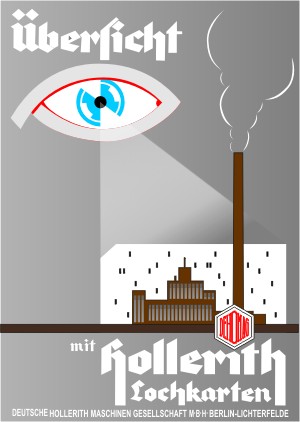
January 2, 2007

|
Mirko's drawing connects IBM to the Holocaust and furthermore suggests that IBM facilitated it. This relationship was elucidated in 2001 with a meticulously documented study, IBM and the Holocaust, by Edwin Black.

Wikipedia
Herman Hollerith, 1860-1929
|
In 1910, Willi Heidinger founded Dehomag (Deutsche Hollerith Maschinen
Gesellschaft) under license from Hollerith's Tabulating Machine Company to lease
Hollerith's machines in Germany. As a result of the post WWI inflation in
Germany, by the early 1920's Dehomag was near insolvency and a 90% share of its
ownership was acquired by Hollerith's successor company, C-T-R, and with the
name change in 1924, this ownership passed to IBM.

Reconstructed from IBM and the Holocaust
Dehomag ad. Text says: "Oversight with Hollerith
punched cards."
Note: This drawing is a reconstruction from a grey scale original. Hence the colors are not correct. |
On January 30, 1933 Hitler was appointed Chancellor by President Hindenberg and on April 12th the new government announced that it would conduct a national census. Its planners decided that they wanted the results for Prussia, the most populous state, with 41 million inhabitants, in four months and they contracted with Dehomag to do the data processing.
Dehomag's job was to take the handwritten census forms and keypunch the data for each person onto a 60 column IBM card and then, using its tabulating machines, to prepare summary reports.
The door-to-door canvassing began on June 16th with 500,000 census takers hired by the government. By mid-September the hand-written forms started coming in to Dehomag for processing by 450 keypunch operators hired and trained by Dehomag and operating in two shifts. The production quota set by Dehomag was 150 cards per hour per operator.
Specifically relevant to the Holocaust was the information punched in colum 22: a hole in row 1 meant the person was a Protestant, row 2 a Catholic, or row 3 a Jew.
Once all the information from the source sheets was keypunched, and using IBM's tabulating machines, the Nazi bureaucrats could, for example, print out a list of names and addresses of all Polish-speaking Jews, between the ages of 40 and 65, living in a particular neighborhood of Berlin. Such lists could be given to the local police officials and thus could the wheels of the Holocaust machinery be set in motion.
OTTO